NOCTUIDAE - Chloridea virescens (Fabricius) *Non-Rep*
Taxonomy
Noctuoidea: Noctuidae: Heliothinae: Chloridea virescens (Fabricius)
Common names: tobacco budworm
Synonyms: Heliothis virescens, Heliothis spectanda, Phalaena rhexiae, Xanthia prasina, Xanthia viridescens
Pogue (2013) resurrected the genus Chloridea for virescens, subflexa, tergemina, and ten other species formally placed in Heliothis.
More information on this change is found in the Taxonomy section under the Detailed Information tab.
Larval diagnosis (Summary)
- Large retinaculum on the mandible
- Dorsal pinacula on A1, A2, and A8 covered with microspines
- Dorsal pinacula on A1 and A2 sometimes connected by a dark bar
Host/origin information
Chloridea virescens is most commonly recorded (80% of records) from the three countries listed here. Identifications from Peru are tentative as C. virescens may
be confused with other Heliothinae (e.g., C. tergemina) in South America (see the Detailed Information tab):
| Origin |
Host(s) |
| Haiti | Cajanus |
| Mexico | Cicer, Physalis, Zea mays |
| Peru | Pisum |
Recorded distribution
Chloridea virescens is widely distributed across the United States and southern Canada, although it does not survive the winter in northern states.
This species is also present in Mexico, Central America, South America, and the Caribbean (Poole et al. 1993).
Identification authority (Summary)
Larvae of C. virescens can be identified to species using the above morphological characters if from North America, Central America, the Caribbean, or Hawaii. Identification
to species in South America is often not possible because of potential confusion with C. tergemina, so it is safer to stop at genus Chloridea. There are no records of
C. virescens outside of the Americas (and Hawaii).
Pest characterization
(Based on Cavey 2001, Poole et al. 2003)
- Taxonomy: High. Species identification is often possible.
- Distribution: Low. Chloridea virescens occurs in the U.S.
- Potential Impact: High. Chloridea virescens is a pest species.
This ranking characterizes C. virescens as not quarantine significant for the U.S.
NOCTUIDAE - Chloridea virescens (Fabricius) *Non-Rep*
Taxonomy (Detailed)
In a recent publication, Pogue (2013) determined that the Heliothis group was not monophyletic, with H. virescens and H. subflexa
forming a clade separate from other members of the genus. To resolve this problem he resurrected the genus Chloridea for virescens, subflexa, tergemina, and
ten other species formally placed in Heliothis. His evidence was based on a phylogenetic analysis incorporating three gene regions as well as morphological
characters and his results agreed with an earlier study performed by Cho et al. (2008). Here we follow this latest taxonomy and use the combination
Chloridea virescens to refer to the tobacco budworm.
Larval diagnosis (Detailed)
The larva of the tobacco budworm, Chloridea virescens, was at least partially described by Garman (1920), Crumb (1956), Okumura (1961),
Peterson (1962), Neunzig (1969), Godfrey (1987), Matthews (1991), Sannino et al. (1993), and Hardwick (1996). Several larval color patterns
were photographed by Hardwick (1996), Cranshaw (2004), Angulo et al. (2006), and Wagner et al. (2011). Early literature was reviewed
Kogan et al. (1978). Passoa (2007) gave a tentative key to separate C. virescens from other quarantine species of Heliothinae.
Typically, C. virescens has a large retinaculum on the mandible and the dorsal pinacula of A1, A2 and A8 are covered with microspines.
The dorsal pinacula of A1 and A2 may be connected by a dark bar (Hardwick 1966), but this is not always true for the large volume of
specimens intercepted by APHIS or a large series of preserved larva from a USDA lab culture (SPIC).
Mandibular terminology can cause confusion. The retinaculum is a projection, sometimes toothlike, on the oral surface of the mandible
(Stehr 1987). Various authors have used the term basal tooth, basal process (Crumb 1956, Boyer et al. 1977) or inner tooth (Godfrey 1987)
to describe the retinaculum of C. virescens. Here we follow Passoa (1985) who restricted the term inner tooth to the small toothlike
projections on a mandibular ridge. Larger projections on the oral surface are called a retinaculum, as in Stehr (1987) and Okumura (1961).
The retinaculum of C. virescens is usually well developed, but depending on the diet (Boyer et al. 1977), it may be reduced to a thin
ridge or groove called a mandibular scar. When the retinaculum is well developed, H. zea, can be eliminated as a possibility because it never
has a large retinaculum on the mandible. Brazzel et al. (1953) and
Neunzig (1969: 11) illustrated the mandibular variation of C. virescens. Because of this variation, presence of microspines covering
the dorsal pinacula of A8 is the most accurate way to identify C. virescens (Boyer et. al 1977).
A pinaculum is called a chalaza if it is elevated and conical (Stehr 1987). Because there is a continuous variation in height from a
pinaculum to a chalaza in larval Heliothis/Helicoverpa, we have chosen the more general term, pinaculum, for all of these situations.
Peterson (1962: L36) used chalazae in his descriptions of Heliothinae.
Separation of C. virescens from H. zea is discussed in the data sheet for H. zea. The presence of a mandibular retinaculum and
microspines on the body pinacula separates most C. virescens from most H. zea. The reduced retinacum in C. virescens and presence
of microspines on the edge of the pinacula in H. zea are the usual exceptions.
Chloridea virescens is associated with several species of Physalis (Robinson et al. 2002) where it can be confused with C. subflexa,
a Physalis specialist. The SD2 seta is surrounded by a sclerotized area in C. subflexa but not in C. virescens (Peterson 1962: L36, Wagner et al. 2011).
Typically, Heliothis phloxiphaga has conical pinacula all over the body. Conical pinacula in C. virescens, if present, are only on
A1, A2 and A8. Some specimens of H. phloxiphaga can be recognized by having dark arcs on the head (Crumb 1926) or pinacula ringed with white (Lange and Michelbacher 1937).
As with H. zea, only the mid- to last instars can be identified by the mandible and cuticle microspines. First and second instars
should be left at subfamily or consult Neunzig (1969) if there is a reason to separate C. virescens and H. zea as early instars. For the quarantine
decisions in the United States, C. virescens, H. zea, C. subflexa, and H. phloxiphaga all have the same action status, thus efforts to identify
earlier instars is usually not justified.
Identification of C. virescens in South America is complicated because the larva of C. tergemina is poorly known. Hallman (1978) suggested that
the two species can be separated by the height of dorsal pinacula on A1 and A2; they are equal in C. virescens but at least 2.5 times as high as
the neighboring segments in C. tergemina. Clearly, this character will not be valid for many PPQ samples. Matthews (1991:41) compared a series
of Heliothinae larvae using photographs. From his figures (Matthews 1991: figs. 696, 697), the hypopharyngeal complex of C. virescens has a
spinose distal region followed by more than ten blades. In contrast, the distal region of the hypophargngeal complex of C. tergemina is smooth
dorsally and there are less than ten blades. The mandible of C. virescens is rectangular, not square like as in C. tergemina
(Matthews 1991: figs. 711, 712). Matthews (1991) did illustrate cuticle texture, but comparisons are premature unless one can be sure the
photos are the same view from the same areas of the body.
The key to Chiliean noctuids by Angulo et al. (2006) included C. virescens but not C. tergemina. Beardsley (1982) used the mandible and
presence of microspines on the dorsal pinacula to identify C. virescens in Hawaii.
Identification authority (Detailed)
Chloridea virescens is highly polyphagous and widely distributed, but there are no records outside of the Americas except for Hawaii.
Using the mandible and microspine distribution characters discussed above, C. virescens can be identified to species from North America,
Central America, the Caribbean, and Hawaii.
It should be noted that H. phloxiphaga occurs only as far south as Mexico, and is quite rare in United States port interceptions. The
other species (H. zea, C. virescens, and C. subflexa) are commonly intercepted.
Identification of C. virescens from South America is often not possible because of potential confusion with C. tergemina. We will give
suggestions as a guide, but it is safer to stop at genus Heliothis. Hallman (1978) noted that C. tergemina was collected only from tobacco
in Colombia. Poole et al. (1993) added Solanum as a host, but there are no records outside the Solanaceae. Thus, specimens from non-solanaceous
hosts are most likely C. virescens if other characters fit. Origin is most helpful. It is possible to identify C. virescens from Guyana,
Suriname, and French Guiana because C. tergemina does not occur in these countries (Poole et al. 1993). The morphological characters we list
to separate C. virescens from C. tergemina all need confirmation.
Interceptions from Chile are best left at subfamily Heliothinae. Jana-Saenz and Angulo (1985) stated that there is a complex of native species
associated with economic plants in that country, Schinia chilensis being an example. Without larval morphology, hostplant information or even
the number of species in the complex, it is hard to know how useful Angulo et al. (2006) would be to PPQ for identification of Heliothinae.
Consult Passoa (2007) for further details on other Heliothis likely to be confused with C. virescens in South America. Besides a need to study
the fauna in Chile, Poole et al. (1993) pointed out C. tergemina is a group of three distinct populations. Hallman (1978) left one larva as
"unknown" in his key. The fauna of South America is in need of more study.
NOCTUIDAE - Chloridea virescens (Fabricius) *Non-Rep*
Origin records
Chloridea virescens has been intercepted from the following locations:
Anguila, Antigua and Barbuda, Barbados, Colombia, Dominican Republic, Ecuador, El Salvador, Guyana,
Haiti, Honduras, Jamaica, Mexico, Nicaragua, Peru, Puerto Rico, St. Kitts and Nevis (?), St. Lucia, St. Maarten, Trinidad and Tobago
Identifications from Peru are tentative as C. virescens may be confused with other Heliothinae (e.g., C. tergemina) in South America
Host records
Chloridea virescens has been intercepted on the following hosts:
Abelmoschus esculentus, Abelmoschus sp., Acacia sp., Achillea sp., Allium fistulosum, Anigozanthos sp., Antirrhinum majus,
Antirrhinum sp., Apium graveolens, Aster sp., Brassica campestris, Brassica sp., Brunia sp., Cajanus cajan,
Campanula sp., Capsicum annuum, Capsicum sp., Carica papaya, Chrysanthemum sp., Cicer arietinum, Cicer sp., Citrus sp., Cucurbita sp.,
Delphinium sp., Fabaceae, Fragaria sp., Helianthus annuus, Helianthus sp., Hydrangea sp., Lablab purpureus, Lablab sp., Lactuca sp.,
Lagenaria siceraria, Limonium sp., Mentha sp., Moluccella sp., Ocimum basilicum, Ocimum sp., Opuntia sp., Origanum majorana,
Origanum sp., Origanum vulgare, Phaseolus lunatus, Phaseolus sp., Phaseolus vulgaris, Physalis philadelphica, Physalis pubescens, Physalis sp.,
Pisum sativum, Pisum sativum var. macrocarpon, Pisum sp., Pithecellobium dulce, Saccharum officinarum, Salvia officinalis, Solanaceae,
Solanum lycopersicum var lycopersicum, Solanum melongena, Thymus vulgaris, Tulipa sp., Vicia faba, Vigna unguiculata, Zea mays,
Zingiberaceae
NOCTUIDAE - Chloridea virescens (Fabricius) *Non-Rep*
Setal map
 Chloridea virescens setal map Chloridea virescens setal map
<< Previous fact sheet Next fact sheet >>
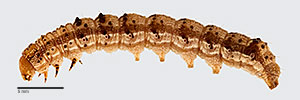 Fig. 1: Late instar, lateral view
Fig. 1: Late instar, lateral view |
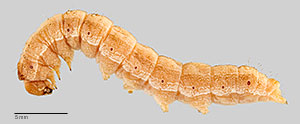 Fig. 2: Late instar, lateral view
Fig. 2: Late instar, lateral view |
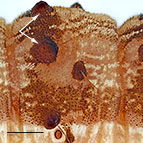 Fig. 3: A2 pinacula; arrows denote microspines
Fig. 3: A2 pinacula |
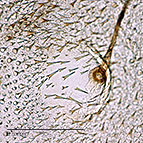 Fig. 4: Microspines on pinacula
Fig. 4: Microspines |
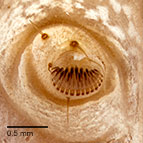
Fig. 5: Crochets |
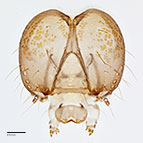
Fig. 6: Head |
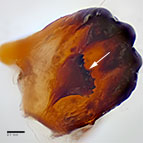 Fig. 7: Mandible; arrow denotes retinaculum
Fig. 7: Mandible |
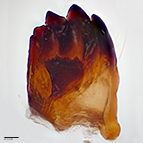
Fig. 8: Mandible |
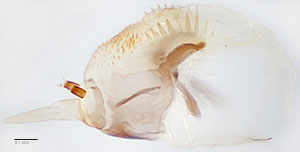 Fig. 9: Hypopharyngeal complex, lateral view
Fig. 9: Hypopharyngeal complex, lateral view |
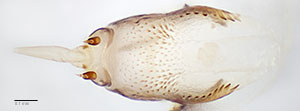 Fig. 10: Hypopharyngeal complex, lateral view
Fig. 10: Hypopharyngeal complex, lateral view |
|
|
|
|
|